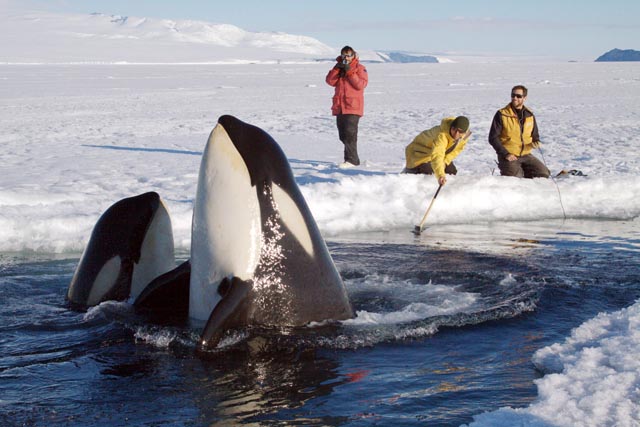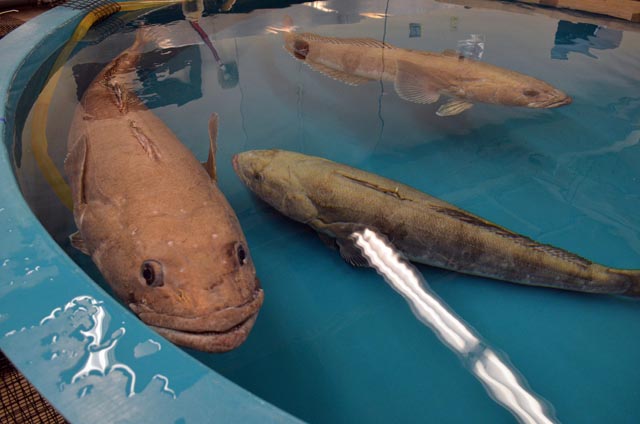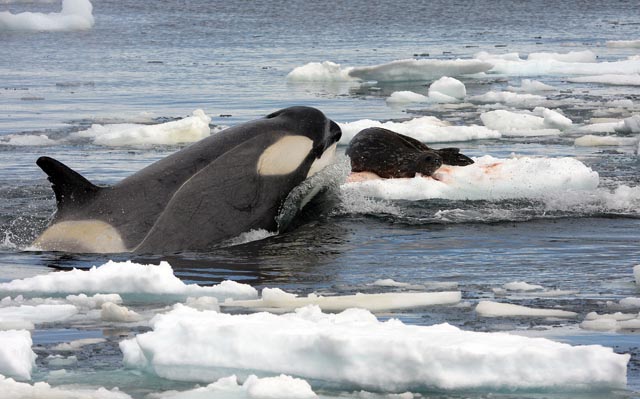|
Page 3/3 - Posted May 24, 2013
Dealing with the wild card of Antarctic toothfishThe question is not just academic. The whales have competition when it comes to hunting the Antarctic toothfish: humans. A sanctioned fishery currently operates in the Ross Sea. Conservationists have lobbied to shut it down or dramatically reduce it because so little is known about the ecology of the Antarctic toothfish, which is marketed under the more benign-sounding name of Chilean sea bass. It’s a topic that riles the soft-spoken Ainley, who argues that his long-term study in penguin population dynamics and their relation to climate effects has been subverted by the impacts the fishery has on the Ross Sea ecosystem. The Antarctic toothfish is itself a top predator, and among its prey are silverfish, also a major prey of the penguins. The fishery is removing a competitor of the Adélies, which are increasing in numbers. “There’s not a climate signal that explains why the Adélie penguins are increasing. In fact, they should be decreasing based on our previous analyses,” Ainley says. “We’re not studying climate change anymore.” Ainley says the extent and duration of sea ice in the Ross Sea region is increasing, which should be problematic for the Adélie penguins because it adds to the distance they must travel between breeding colonies and wintering grounds. However, he says, if more silverfish are available due to depleted Antarctic toothfish stocks, then that might offset the challenges associated with sea ice. (The cause as to why sea ice cover is changing is still being debated, with one long-time hypothesis — blaming ozone depletion in the stratosphere — being contested by other theories and climate models in recent years.) “The toothfish fishing is the wild card,” Pitman acknowledges. “If it turns out that the Ross Sea killer whale is relying on toothfish heavily, it’s a problem. If not, it’s still important but not as critical.” The unavailability of the icebreaker channel the first season of the project is also important but not critical. Pitman and Durban, like their SCINI team members, made do with the sea ice edge. The duo flew repeatedly across McMurdo Sound aboard a helicopter, about 30 kilometers from the research station. These weren’t mere whale watching trips. Like Ainley, the NOAA researchers outfitted their subjects with satellite tags, small transmitters capable of staying on the whales over multiple months. The tags relay a whale’s location dozens of times per day, as well as record dive depths every 90 seconds. “That can fill some data gaps pretty quickly,” Durban notes. “Every time [the whale] comes back to the surface the tag transmits its information.” The researchers (under permit Antarctic Conservation Act The biopsy can give them insight into the animal’s diet. Images help the researchers identify and count the whales (they are all individually distinctive, especially from scars) to get more accurate counts of the population. The latter information is particularly important if Pitman, Durban and their colleagues want to accurately quantify how much biomass the whales are consuming. “The killer whales are removing as much fish as a large-scale fishery,” Durban notes. “What we’re basically trying to do is a fisheries assessment for killer whales.” Next season, with the icebreaker slotted to hit the sea ice edge in early January, the team will return with hopes to fish the channel for additional answers about the links within the Last Ocean food web. “The icebreaker changes things — it changes the balance,” Durban adds. How that balance changes — who is eating whom, when and where — may become clearer in the coming years. “I think by creating a better picture of the food web in the Ross Sea and how all the pieces are related, we will provide information that is relevant not only to ecologists but also to natural resource managers,” Kim says. NSF-funded research in this story: Stacy Kim, San Jose State University, Award No. 0944747 |



For USAP Participants |
For The Public |
For Researchers and EducatorsContact UsU.S. National Science FoundationOffice of Polar Programs Geosciences Directorate 2415 Eisenhower Avenue, Suite W7100 Alexandria, VA 22314 Sign up for the NSF Office of Polar Programs newsletter and events. Feedback Form |




